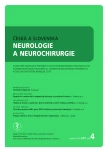Swallowing difficulties in diffuse idiopathic skeletal hyperostosis
Authors:
I. Štětkářová 1; J. Chrobok 2
Authors‘ workplace:
Neurologické oddělení Nemocnice Na Homolce, Roentgenova , Praha
1; Neurochirurgické oddělení Nemocnice Na Homolce, Roentgenova 2, Praha
2
Published in:
Cesk Slov Neurol N 2007; 70/103(4): 435-440
Category:
Case Report
Práce byla podpořena grantem IGA NR/7773-3
Overview
Objective:
Diffuse idiopathic skeletal hyperostosis (DISH, Forestier's disease, ankylosing hyperostosis) can manifest as large anterior osteophytes in the cervical spine region. Clinical symptoms are often mild, taking the form of unspecified local pain and blockades in the cervical spine. Swallowing or phonation difficulties are rather rare. If also massive posterior osteophytes are present, they can compress the nerve roots or the spinal cord. The article describes the diagnosing and surgical treatment of anterior osteophytes which can cause swallowing disturbances.
Method:
We report 4 patients with swallowing disturbance as the dominant symptom. Two patients reported difficulty in swallowing of solid food, one patient had local spasms and pains in the front part of the neck in addition to the above problems. One patient suffered from compression of nerve structures due to osteoproductive changes and instability of the cervical spine in addition to swallowing difficulties. An X-ray examination of the cervical spine and of the act of swallowing and a CT examination of the neck were performed in each patient. Spinal cord compression was ascertained by means of magnetic resonance imaging (MRI) of the spine and complementary electrophysiological examinations were performed (EMG, somatosensory and motor evoked potentials) in one patient.
Results:
Dramatic relief after the ablation of osteophytes was observed in all the patients. In one of the patients, a dramatic post-surgical improvement of the neurological disorder was observed in addition to decompression of the nerve structures.
Conclusion:
Compression of the oesophagus and trachea by anterior osteophytes should be taken into consideration in differential diagnosing of swallowing and phonation difficulties. X-ray examination of the act of swallowing and CT examination of the neck are important. In spite the risk involved in the surgery (e.g. perforation of the oesophagus), ablation of anterior osteophytes brings immediate relief. In case of clinical symptoms of spinal cord or root compression, also decompression of nerve structures should be performed.
Key words:
DISH – M. Forestier – anterior osteophytes – swallowing difficulties
Sources
1. Julkunen H, Knekt P, Aromaa A. Spondylosis deformans and diffuse idiopathic skeletal hyperostosis (DISH) in Finland. Scand J Rheumatol 1981; 10(3): 193-203.
2. Kiss C, O’Neil TW, Mituszova M, Szilagy M, Poor G. The prevalence of diffuse idiopathic skeletal hyperostosis in a population-based study in Hungary. Scand J Rheumatol 2002; 31(4): 226-229.
3. Resnick D, Shaul RS, Robins JM. Diffuse idiopathic skeletal hyperostosis (DISH): Forestier’s disease with extraspinal manifestations. Radiology1975; 115: 513–524.
4. Žilnay D, Pavelková A. Difúzní idiopatická skeletální hyperostóza – ankylozující hyperostóza. In: Pavelka K, Rovenský V et al. Klinická revmatologie. Praha: Galén 2003: 621-635.
5. Kiss C, Szilagyi M, Paksy A, Poor G. Risk factors for diffuse idiopathic skeletal hyperostosis: a case-control study. Rheumatology (Oxford) 2002; 41(1): 27-30.
6. Sarzi-Puttini P, Atzeni P. New developments in our understandign of DISH (diffuse idiopathic skeletal hyperostosis). Curr Opin Rheumatol 2004; 16(3): 287-292.
7. Sencan D, Elden H, Nacitarha V, Sencan M, Kaptanoglu E. The prevalence of diffuse idiopathic skeletal hyperostosis in patients with diabetes mellitus. Rheumatol Int 2005; 25(7): 518-|521
8. Vezyroglou G, Mitropoulos A, Antoniadis C. A metabolic syndrome in diffuse idiopathic skeletal hyperostosis. A controlled study. J Rheumatol 1996; 23(4): 672-676.
9. Aydin E, Akdogan V, Akkuzu B, Kirbas I, Nuri Ozgirgin O. Six cases of Forestier syndrome, a rare cause of dysphagia. Acta Otolaryngol 2006; 126(7): 775-778.
10. Nelson RS, Urquhart AC, Faciszewski T. Diffuse idiopathic skeletal hyperostosis: a rare case of dysphagia, airway obstruction, and dysphonia. J Am Coll Surg 2006; 202(6): 938-942.
11. Song J, Mizuno J, Nakagawa H. Clinical and radiological analysis of ossification of the anterior longitudinal ligament causing dysphagia and hoarseness. Neurosurgery 2006; 58(5): 913-919.
12. Matan AJ, Hsu J, Fredrikson BA. Management of respiratory compromise cause by cervical osteophytes: a case report and review of the literature. Spine J 2002; 2(6): 456-459.
13. Di Vito J. Cervical osteophytic dysphagia: Single and combined mechanisms. Dysphagia 1998; 13(1): 58-61.
14. Kimura J. Electrodiagnosis in diseases of nerve and muscle: principles and practice. Oxford: Oxford University Press 2001.
15. Bednařík J, Kadaňka Z, Voháňka S, Novotný O, Šurelová D, Filipovičová D et al. The value of somatosensory and motor evoked potentials in pre-clinical spondylotic cervical cord compression. Eur Spine J 1998; 7: 493-500.
16. Dvorak J, Sutter M, Herdmann J. Cervical myelopathy: clinical and neurophysiological evaluation. Eur Spine J 2003; 12: S181-S187.
Labels
Paediatric neurology Neurosurgery NeurologyArticle was published in
Czech and Slovak Neurology and Neurosurgery

2007 Issue 4
Most read in this issue
- Cervical dystonia
- Levels of D-dimers in patients with acute ischaemic stroke
- Thrombosis of the sigmoid sinus – current views on diagnosing and treatment
- Repetitive transcranial magnetic stimulation and chronic subjective tinnitus
